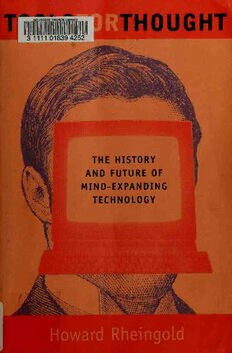
Tools for Thought: The History and Future of Mind-Expanding Technology (The MIT Press) PDF
Preview Tools for Thought: The History and Future of Mind-Expanding Technology (The MIT Press)
THOUGHT. Howard Rheingold H BEL-TIB BOOKS ^^r^^ I 303. 4834 Rhein- gold 2000 Rheingold, Howard ^-MniHyUHlU Tools for thought the I I : history and future of mind-expanding technology The History and Future of Mind-Expanding Technology THOUGHT TOOLS FOR The MIT Press Cambridge, Massachusetts London, England First MIT Press edition 2000 © 1985 Howard Rheingold Firstpublished in 1985 by Simon & Schuster/Prentice Hall. All rights reserved. No partofthisbookmaybe reproduced inanyform byanyelectronic or mechanical means (including photocopying, recording, or information storage and retrieval) withoutpermission in writingfrom the publisher. Printed and bound in the United States ofAmerica. Library ofCongress Cataloging-in-Publication Data Rheingold, Howard. Tools for thought : the history and future of mind-expanding technology / Howard Rheingold. p. cm. Reprint. Originally published: NewYork Simon & Schuster, 1985. : Includes bibliographical references and index. ISBN 0-262-68115-3 (pbk. : alk. paper) 1. Microcomputers—History. 2. Technological innovations—History. I. Title. QA76.5. R467 2000 303.48'34-dc21 99-087051 Preface to the MIT Press Edition At the beginning of the 1980s, powerful personal computers and global com- puter networks ofmillions ofcomputers were not the fact oflife they became at the end of the 1990s. Indeed, the world of information and communication technology that influences so much of our lives today was not created by the existingcomputer industry, norwas itchampionedbythe orthodoxyofcomputer science. Rather, it was built by a handful ofrebels who weren't seeking fame or fortune, but spent their lives creating a new tool for enhancing human thought. They created it because they wanted it for their personal use, because it was a cool thing to do, and because they thought it would improve the human lot. When Apple and Microsoft were fledgling companies, most of what was written about the emerging personal computer industry was about teenage mil- lionaires. Ifyou were to trust what you read in the popular press, the personal computerwas invented by Steve Jobs and Bill Gates. In fact, any journalistcould get a pretty good idea ofwhat life might be like two decades in the future ifthey visited Xerox Palo Alto Research Center in the late 1970s—the place Jobs and Gates got all their best ideas. The real story of where PGs and networks came from was, to me, both more interesting and more fundamentally importantthan the popular mythology of Silicon Valley. Seventeen years ago, I sought out PARC's Alan Kay, ARPA's C. R Licklider and Bob Taylor, and SRI's Doug J. Engelbart, because I was personally fascinated with the idea that computers could one day be used to help people think, communicate, and solve problems together. In 1999, I revisited Engelbart, Kay, Taylor, and others I first encountered in 1983. We talked about the way the future looked when they started creating it, the way it has actually turned out, and the possible futures for mind-amplifying technology. Retrospective futurism about technology is considerably easier than trying to foresee where our tools are really going to take us next. It's particularly tasty ifMIT Press pays you to do it. Atthe end ofthis edition is an afterword that attempts to look back on how we looked forward in 1983, when the book was written. Acknowledgments This book would not have been conceived and could not have been written withoutthe generous and patient assistance ofmany people. My heartfeltthanks to Rita Aero, Avron Barr, John Brockman, Donald Day, Robert Eckhardt, Doug Engelbart, Brenda Laurel, Howard Levine, Judith Maas, Geraldine Rheingold, Alan Rinzler, Charles Silver, Marshall Smith, Bob Taylor, David Rodman, and Gloria Warner. Digitized by the Internet Archive in 2011 http://www.archive.org/details/toolsforthoughthOOrhei To Nathan Rheingold, who gave me the most important thing a man — can ever give his son an example.
